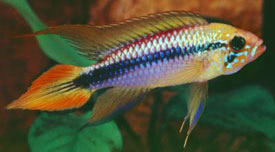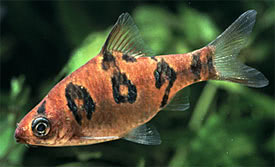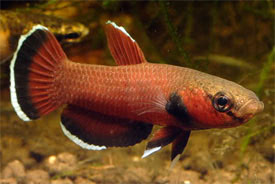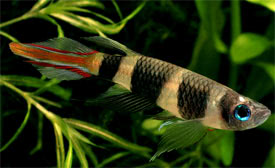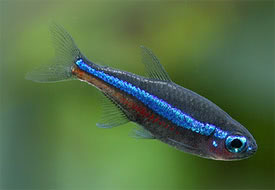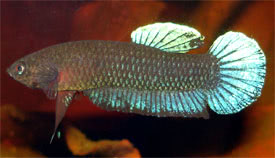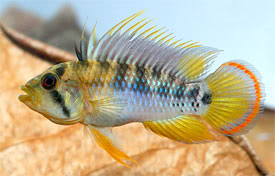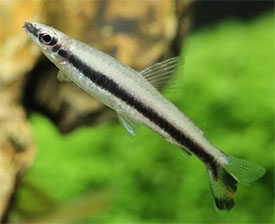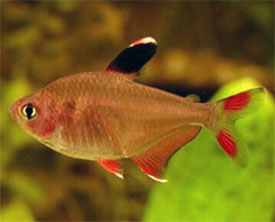
 Magyarul / Hungarian
Magyarul / Hungarian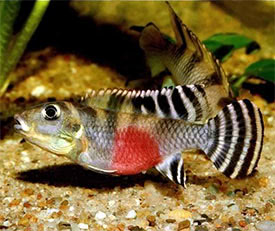
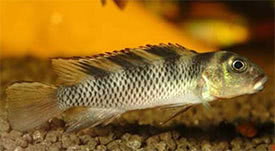
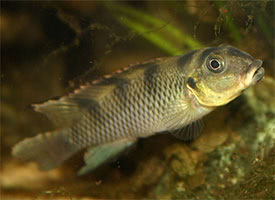

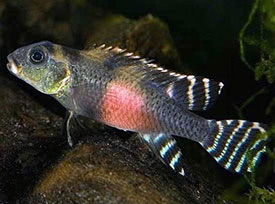
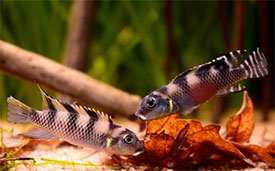
- Scientific name: Nanochromis transvestitus
- Synonyms: -
- Common name:-
- Group: Cichlids
- Habitat: Africa; Democratic Republic of the Congo, endemic to Lake Mai Ndombe
- Size: 3-4 cm
- Biotope: Found in the blackwater lake, mostly at the shallow parts (depth of around 1 m) in rocky areas which has a sandy substrate.
- Social behavior: Relatively peaceful with other fish, but they should be kept in a species tank in pairs, as males can be quite aggressive and territorial with conspecifics.
- Diet: Omnivorous; In nature they feed on small aquatic invertebrates, in the aquarium they usually accept all kinds of live and frozen foods or even quality dried foods, but some specimens can be picky eaters accepting only live foods.
- Breeding: Quite hard
- Tank: Minimum 60 litres.
- Population: 1 pair for 60 litres
- Decoration: They require a lot of hiding places, that can be build from clay pots, rocks and driftwood. Plants are not necessary, but they make the fish more secure. They like to dig in the substrate, so a sandy bottom is recommended. Filtering their water through peat is also useful in recreating the tannin-stained waters of their natural habitat.
- Temperature: 24-27 °C
- pH: 4-7
- Hardness: 0-12 NK°
- Lifespan: 3-5 years
Description: Both sexes have gray to olive brown body with several dark vertical bars that extend into the dorsal fin. The female has a vertical black and white stripes on her anal, caudual fins and some markings at the end of the dorsal fin, while the male has greyish fins. The scientific name (transvestitus) is also derived from the fact that the female is the more colorful fish. Because of their very specific water requirements, they are not recommended to the beginner aquarists. It is said that they grow bigger in aquarium, females may grow to about 4.5 cm in length while the males may reach up to 6.5 cm. Nanochromis transvestitus is added to the IUCN Red List of Threatened Species as endangered, because they only known from Lake Mai Ndombe, and due the local fishing practice of using small mesh size nets (mosquito nets), which poses a threat to the populations, as catches every species of fish in the lake regardless of size. For breeding purposes it is best to buy a small group of young fish, and wait until a pair will form, then the rest of the fish can be removed from the tank.
Females are more colorful than males, having a red colored belly and flanks. Adult males usually develop small extensions to the dorsal and anal fins, and they are a little longer than females. Their breeding is not easy, as they require very soft and acidic water and they usually not spawn in water with a pH value of much above 6.0, or thay may spawn, but the eggs will not hatch. The fish usually spawn in pits that they dug under the rocks or driftwoods. The male can be very aggressive during courtship, although pairing is actually initiated by the female. In an enclosed space such as a fish tank the female is essentially trapped within the males territory, and she can’t swim away as in the nature when she is not ready to spawn. This is why as many hiding places as possible must be built in the aquarium. Quality foods are also important if we want to breed them: the pair should be conditioned on a varied diet of live and frozen foods. During the courtship and spawning the pair will take on more intense coloration and the female will begin to display at the male and bend her body into an “S” shape and shows off her bright red belly. The number of the eggs can vary between 40 and 70. After spawning the female take care of the eggs, while the male will defend the spawning site. The eggs hatch in 3-5 days and the larvae become free-swimming after 7 days. The fry are quite big and can be fed with newly hatched brine shrimp nauplii. In the first weeks the fry are very sensitive to the changes in the water quality. The parents will usually care for their fry for about a month, after they may spawn again. Predation of the fry by the parents is very rare. Their sex is easily determined by the patterning on the tailfin. At two months old, with an average size of 2 cm they become territorial and have constant fights for the control of any small shelter. At about 4.5 months of age the female specimens already display white stripes on their caudal fin, and at 8 months of age the first stable pairs are appear. First spawning can happen from month 10 to 12.























